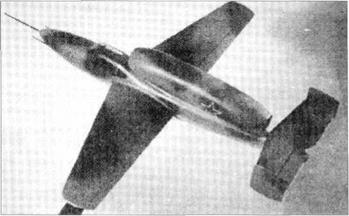Antonov M
Purpose: To create a superior jet fighter.
Design Bureau: No 153, Oleg K Antonov, Novosibirsk.
In 1945 Antonov was impressed by the German He 162, and considered it a good way to produce a simple fighter for rough-field use powered by a single turbojet. In spring 1947 his staff had completed the design of the SKh (later designated An-2), and he quickly schemed a fighter to be powered by a single RD-10 (Soviet-made Junkers Jumo 004B) above the fuselage. He tested a tunnel model, but on 6th April 1947 received an instruction from NKAP (the state commissariat for aviation industry) to design a fighter with two RD-lOs. By this time he had recognized that jet engines not only made possible unconventional new configurations for fighters but might even demand them. He quickly roughed out the Masha, abbreviated as the ‘M’. A A Batu – mov and V A Dominikovskiy were appointed chief designers, with 11 Yegorychev in charge of construction. Design was virtually complete when in late 1947 the NKAP instructed OKB-153 to redesign the aircraft to use the RD-45, the Soviet-built copy ofthe Rolls-Royce Nene. Apart from the forward fuselage, the redesign was total. Following tunnel testing of models, and free-flight testing of the E-153 (which was used as both a detailed full-scale wooden mock-up and a towed glider), construction of the M prototype went ahead rapidly. In July 1948, when the prototype was almost ready, and Mark L Gallai was about to begin flight testing, the project was cancelled. The La, MiG and Yak jet fighters were thought sufficient. (In 1953 Antonov again schemed a j et fighter, this time a tailed delta powered by an AL-7F, but it remained on paper.)
The original 1947 form of the Masha featured side inlets to the RD – 10 engines buried in the thick central part of the wing. Outboard were
|
Model of the 1947 jet fighter project. |
broad wings tapered on the leading edge with squared-off tips carrying swept fins and rudders. Beyond these were small forward-swept ailerons. The main wing had leading-edge flaps and aft spoilers. Having studied side doors to the cockpit, Antonov settled for a sliding canopy. Armament comprised two VYa-23 and two B-20. This armament remained unchanged in the M actually built, which had a single RD-45, rated at 2,270kg (5,000 Ib) fed by cheek inlets. The wing was redesigned as a round-tipped delta, with the swept vertical tails positioned between two pairs of tabbed elevons.
Antonov considered that the final M ought to have been allowed to fly. He considered it would have dramatically outmanoeuvred any contemporary competition, and could later have had radar and a more powerful engine.
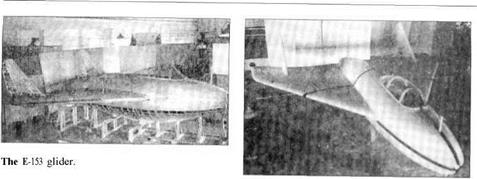
|
||||||||||||
|
||||||||||||
|
||||||||||||
|
|
||||||||||||
|
||||||||||||
|
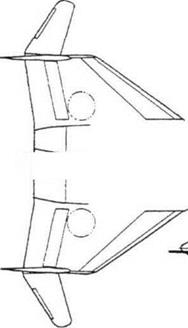
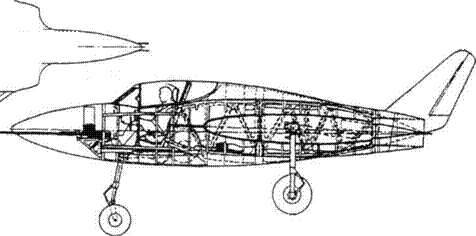
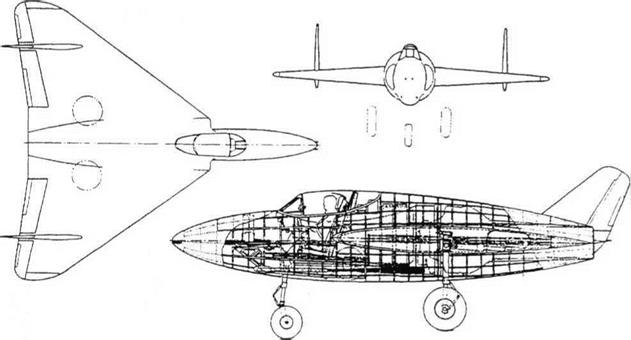
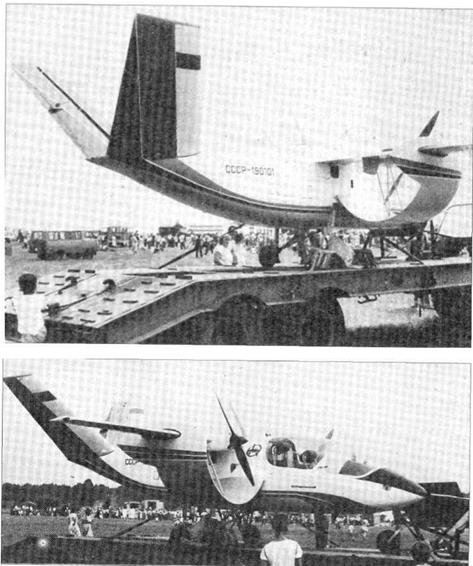
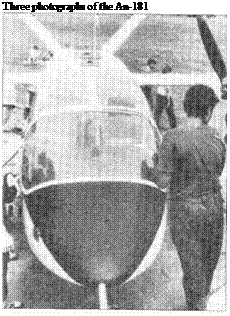
Purpose: To explore the Custer channelwing concept.
Design Bureau: Oleg K Antonov, Kiev, Ukraine.
Little is known about this research aircraft, other than what could be gleaned by walking round it on 18th August 1990 and reading the accompanying placard. Its one public outing was on Soviet Day of Aviation, and the venue the airfield at the village of Gastomel, near Kiev. The configuration was instantly recognisable as being that of the ‘channel-wing’ aircraft proposed by American W R Custer in the mid-1950s. The key factor of this concept was powered lift gained by confining the propeller slipstream in a 180° half-barrel of aerofoil profile. Custer claimed the ability to take off and climb almost vertically, or to hover, whilst retaining full forward speed capability. Resurrecting the Custer concept was astonishing, as the claims for the channel-wing aircraft were soon shown to be nonsense, and instead of 1958 being the start of mass-production of the CCW-5 series version the whole thing faded from view. It was thus totally unexpected when the ‘181’ appeared at an Open Day hosted by the Antonov OKB. It was not just parked on the grass but tied down on a trailer. Visitors were able to climb on to this and study the aircraft intimately, but there was nobody to answer questions.
The ‘181’ was dominated by its two Custer – inspired channel wings, with aerofoil lifting surfaces curved round under the propellers so that they were washed by the slipstream. Whereas the Custer CCW-5 had pusher propellers above the trailing edge, the Antonov aircraft had tractor propellers above the leading edge. They were driven via shafts and gears by a 210hp Czech M-337A six-cylinder aircooled piston engine. Apart from this the aircraft appeared conventional, though the tail was of ‘butterfly’ configuration to keep it out of the slipstream, and of exceptional size in order to remain effective at very low airspeeds. Beyond the channel wings were small outer wings with ailerons. The nose was fighter-like, with a large canopy over the side-by-side cockpit, and the tricycle landing gear was fixed. The nose carried a long instrumentation boom, and there was a dorsal antenna, presumably for telemetry. The whole aircraft was beautifully finished, and painted in house colours with the Antonov logo. It bore Soviet flags on the fins, and civil registration SSSR-190101.
Construction of this research aircraft must have been preceded by testing of models. These must have given encouraging results, which were not reproduced in the ‘181’. Coauthor Gunston asked Antonov leaders about the ‘181’ and was told that it had been a serious project, but perhaps ought not to have been put on view.
|
Dimensions Span Length Wing area (total projected) |
7.3m 7.31m 7.0m2 |
23 ft m in 23 ft 11% in 75 ft2 |
|
Weights |
||
|
Weight loaded (normal) |
820kg |
l,8081b |
|
(maximum) |
900kg |
l,9841b |
|
Performance |
||
|
Maximum speed (placard) |
820 km/h |
510 mph |
|
Range (placard) |
750km |
466 miles |











